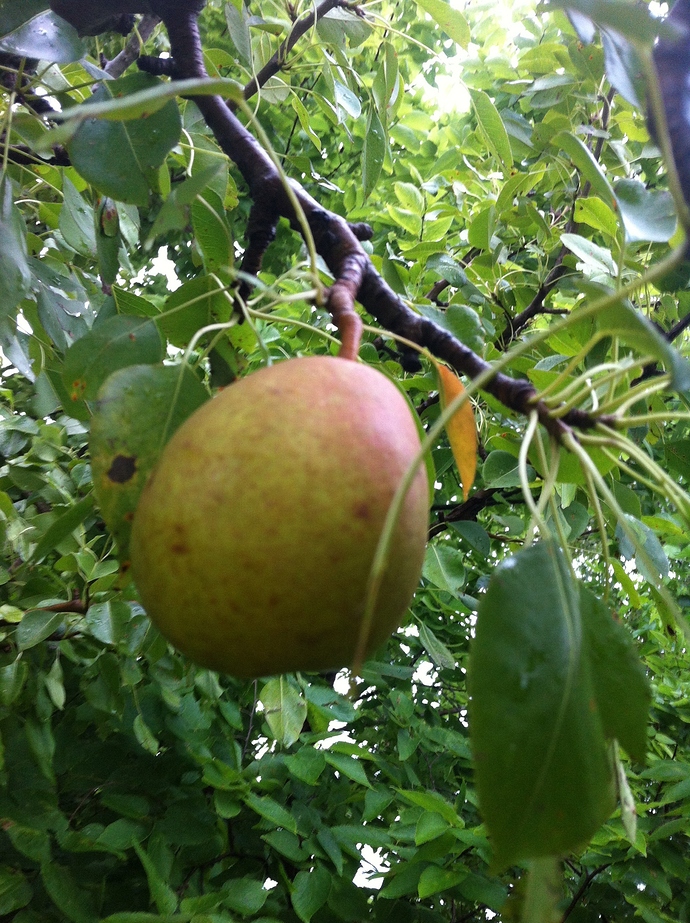Katy,
On my smart phone now so I will look once I’m home today or tommorow and can see better on the computer. What I can tell already is that they all have sand pear in their genetics based on leaves and bark just like a kieffer. You might want to look at this old thread for a little more explanation Identifying pears by their leaves - #11 by clarkinks. I don’t have a mature orient pear but you can see the fruit at this site http://npgsweb.ars-grin.gov/gringlobal/accessiondetail.aspx?accid=%20PI+541954 . Many of these things in the description fit but the pictures leave me scratching my head "
Narrative
Orient (PI 541954).-Originated in Chico, California, by Walter Van Fleet, Plant Introduction Garden, U.S. Dept. of Agriculture. Introduced in 1945 through the Tennessee Agriculture Experiment Station. Pyrus communis x Pyrus sp. from China; direction of cross unknown; P.I. 64224. Fruit: nearly round, averaging 3 inches long and 2 3 / 4 inches in diam.; flesh firm, juicy, slightly sweet, lacking in flavor; good for canning; ripens 15-18 Aug. at Knoxville, Tennessee. Bruises easily when ripe; skin thick and tough, with rough finish; flesh creamy-white, good texture, mild flavor, grit near core, resistant to core breakdown. Tree: produces annual medium-sized crops; resistant to fire blight; mostly of interest in Tennessee and southward. - Brooks and Olmo Register of Fruit and Nut Varieties". The ripening times and everything else is right which in that location is August 15-18th and you would ripen slightly before that. This is more about kieffer https://npgsweb.ars-grin.gov/gringlobal/accessiondetail.aspx?accid=%20PI+541714 "
Narrative
Grown from a seed of a Sand Pear by Peter Kieffer of Roxborough, Pennsylvania. Presumed to be a cross of Sand Pear and Bartlett. First fruited in 1863 and the first Sand Pear hybrid to assume importance. It is the standard by which other varieties of the group are judged. Fruit medium or larger in size, ovate in form, usually pointed at both stem and calyx ends. Skin greenish-yellow in color, often blushed dull red, numerous large russet dots. Flesh gritty, fairly juicy, tender but not fully buttery. Fair in dessert quality, quite satisfactory for culinary purposes. Improves in quality if harvested at the proper time and ripened at a constant tempeature of 65 degrees F. Tree fairly vigorous, moderately productive, somewhat resistant to fire blight. – H. Hartman, 1957.
About 1855 Peter Kieffer of Roxborough, Pa., planted seed from a Chinese Sand pear tree growing in his yard and generally considered to have been pollinated by a Bartlett tree nearby, from which the original Kieffer tree sprang. Possibly no other pear has been so loudly praised and yet so roundly cursed. For years after its introduction there were bitter battles waged over the blight proof character of the tree and the high quality of the fruit. But now that the smoke has cleared away and the issue is less befogged by violent discussion, the virtues and faults of the Kieffer can be more intelligently discussed. The large-sized, symmetrical, oval fruits, clear yellow in color, and often blushed on the side next the sun, are attractive to the eye, but the coarse, granular, though juicy, yellowish-white flesh is so lacking in flavor that it is rated by the palate as ‘poor in quality.’ For culinary use, however, Kieffer has virtues often forgotten or overlooked, for when canned its firm, white flesh is attractive and pleasing. There are rumors from time to time of Kieffer pears shipped to other countries to return in cans marked ‘Bartlett,’ so that perhaps the very man who decries the Kieffer the loudest is this moment loud in his praise of a canned Kieffer under the guise of ‘Bartlett.’ There is no ‘blight-proof’ pear. Kieffer is as blight-resistant as any, which amounts in some sections to the same thing as being blight-proof. Nurserymen delight in the free, vigorous growth of the trees, a habit that it does not cease when in the orchard. It comes into bearing young, is resistant to scale, and bears annually and abundantly. In fact, it is necessary to guard against the danger of overbearing, or the reward will be nothing but small-sized fruit. Because of the vigor of the tree and its tendency to overbear, it has come to be the system in sections to stub the trees every year. While this seems to be a necessary practice as the tree gets older, it will be found that the tree will come into bearing much earlier if it can be left to grow more to itself the first few years of its life and then be taken into hand before it gets beyond control. As for top-working the Kieffer, generally speaking the operation is a failure. Most success has been with very young trees. Possibly the chief virtue of the Kieffer pear is its adaptability to a wide range, and especially to the warm, dry sections of America, such as the South and the Middle West, where the European pear, adapted as it is to cool, moist regions, will not thrive. The nature of its seed parent exerts itself in its offspring, and the range of pear growing is thereby greatly extended. In some years, Kieffers are a glut on the market, but it is noticeable the producer of large-sized, well-matured fruits is neither worried nor affected by low markets. Blight has taken a heavy toll from Eastern pear orchards in recent years, so that the time may be approaching when a higher price will prevail generally. Yet it must be affirmed that where the better varieties can be grown it is a mistake to plant the Kieffer." With all that said there are hundreds of new hybrids and some of these unknown pears could be any of them.

























